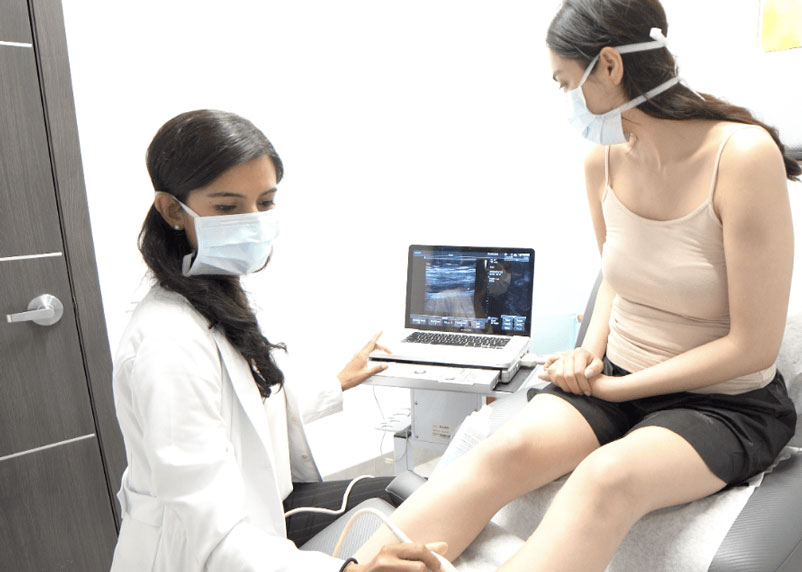Step 1: Identify the symptoms of vein disease
The first step in your varicose vein treatment journey is simply identifying the problem. You might think identifying varicose veins is simple — they’re large and bulging blood vessels that protrude out of your skin’s surface. But while varicose veins are easy to identify, other signs and symptoms of vein disease (the root cause of vein problems) might be a little harder to detect. You should ideally consult vein doctors for your treatment even before you notice varicose veins, i.e. when the first signs and symptoms of chronic venous insufficiency appear.

Chronic venous insufficiency is a medical condition wherein the collapse of vein valves leads to backward blood circulation and the eventual accumulation of blood in leg veins. Most vein problems are caused by underlying vein disease. Spider veins and varicose veins are the most visible signs of vein disease, but this medical condition can also lead to numerous invisible symptoms that resemble signs of aging or exhaustion. If left untreated, venous insufficiency continues worsening, eventually leading to major complications. That’s why it’s important to identify the initial signs and symptoms.
Identifying spider veins and varicose veins
Spider veins and varicose veins are the most visible signs of chronic venous insufficiency. Spider veins are dense clusters of red or blue blood vessels that appear on the skin’s surface, looking like a mass of spider webs. Varicose veins are blood vessels that bulge out of your skin’s surface, looking like a mass of twisted, tangled, and knotted ropes. Spider veins are usually harmless, even though they’re caused by a dangerous medical condition, but varicose veins are usually dangerous. If left untreated, varicose veins can eventually burst and cause severe bleeding.

Identifying the signs and symptoms of chronic venous insufficiency
Chronic venous insufficiency is one of the most underdiagnosed medical conditions because its initial signs and symptoms are misattributed to aging or exhaustion. Most people only seek vein treatment once the underlying condition has progressed considerably. The earliest signs and symptoms of vein disease include leg heaviness, leg pain, frequent muscle cramps on the legs, and restless leg syndrome. The symptoms worsen at the end of the day or after long periods of sitting or standing still. If you notice these signs and symptoms, it’s time to contact reliable vein doctors near your location.
Step 2: Conservative solutions for varicose veins and spider veins
Once you identify spider veins, varicose veins, and the other signs and symptoms of chronic venous insufficiency, it’s time to consider your options. Chronic venous insufficiency can’t be treated without medical intervention — the only way to treat spider veins and varicose veins is through minimally invasive procedures. But you can make some lifestyle changes to alleviate the discomfort caused by varicose veins and prevent the condition from worsening. Below, we highlight a few conservative solutions to improve blood flow and prevent vein disease from worsening.
Wear compression stockings regularly
Compression stockings are skin-tight garments that apply pressure on your leg veins, pushing accumulated blood towards the heart. If you have spider veins or varicose veins, you must wear compression stockings regularly. They will push some of the accumulated blood towards the heart, alleviate the discomfort of vein disease, and prevent the condition from worsening.
Engage in exercises that activate calf muscles
One of the best ways to alleviate the leg pain and symptoms of vein disease is through exercise. You should engage in cardiovascular exercises that activate your calf muscles, such as running, swimming, cycling, and yoga. These exercises will engage your calf muscles and push some of the accumulated blood towards the heart, reducing the symptoms of vein disease.
Elevate your legs while sitting down
While sitting down, you should elevate your legs above your heart’s level. You can also prop your legs up on pillows while lying down, thus enlisting gravity to help push some of the accumulated blood towards your heart.
Stand up and walk around frequently
If you have spider veins and varicose veins, you must stand and walk around frequently. Vein disease worsens when you spend long periods of time sitting or standing still. That’s because blood can accumulate in the leg veins if you don’t move them frequently. If you have a desk job, take short breaks to walk around every 30 minutes.
Step 3: Contact a reliable vein doctor specializing in minimally invasive vein treatments
Conservative lifestyle changes may improve the symptoms of vein disease, but they won’t treat the root cause. The only way to remove varicose veins on your legs permanently is through minimally invasive vein treatments, such as radiofrequency ablation, endovenous laser ablation, venaseal, foam sclerotherapy, and ambulatory phlebectomy. You must contact a reliable vein doctor specializing in the latest and safest minimally invasive vein treatments.
During your appointment, the vein doctor will examine your leg veins, discuss your goals, review your health history, and administer ultrasound diagnostic scans to determine if you truly have chronic venous insufficiency. If you’re diagnosed with vein disease, the vein doctor will curate a minimally invasive vein treatment plan for you. The first step of the vein treatment is to collapse the diseased saphenous vein responsible for your vein problems, following which the superficial varicose veins can be removed.
During your vein treatment, the vein doctor will use thermal energy (radiofrequency ablation), laser ablation (endovenous laser ablation), or medical adhesives (venaseal) to collapse the diseased saphenous vein, turning it into a hardened tissue eventually absorbed by the body. Once the diseased vein is removed, the accumulated blood will automatically reroute into healthier leg veins. The treatment should conclude within an hour, and it liberates you from spider veins and varicose veins for good.








